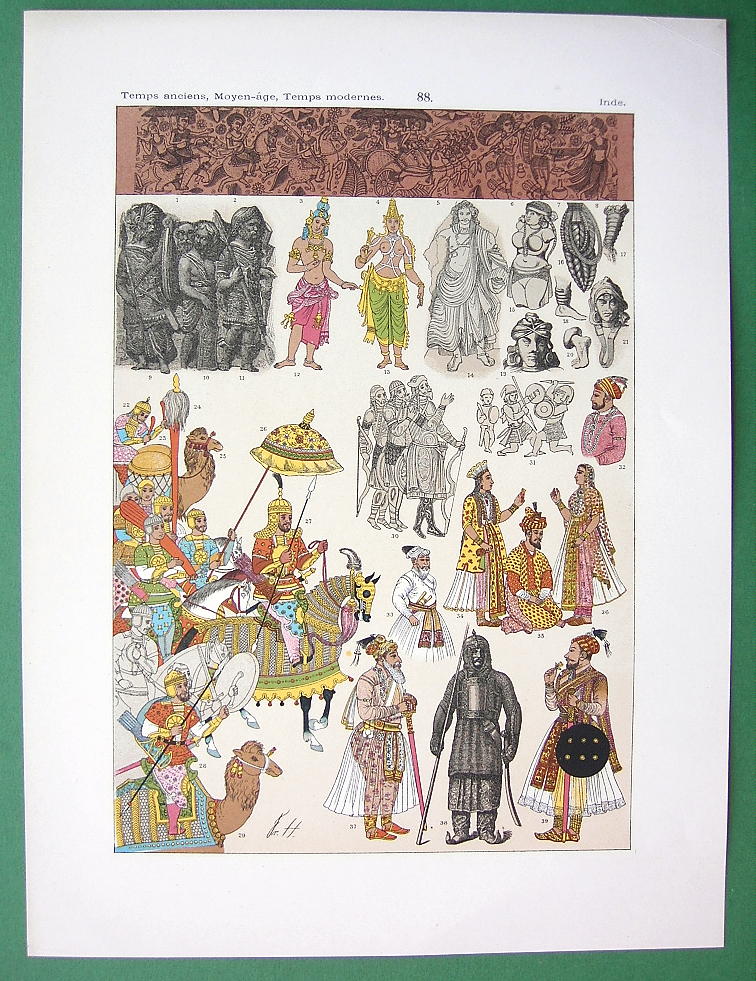

An overview of Indian costumes through the centuries, plate 88
Source: ebay, Dec. 2005
"Legend:
Fig. 1. Ornaments from a water vase, 300 BC, 9-11. Indo-scythes, 100
AD, 12-21. Various temple sculptures, 22-30, 32-37, 39. Indo-mongols,
(Babien,
33. Suliman Moasfdin, 34, Fiancee, 35. Emperor Humaiun, 1530-1556, 36.
Woman, 37. Dschihan Khan, 39. Shah Soliman, ), 31. Indian warrior, 1200
AD, 38. Polygarian warrior (central India). 22-29: These
fragments
are taken from a 16th C. painting representing Djahir - El-din
Mohammed,
Bâber nicknamed (the Tiger), the king and emperor of India,
leaving at the head of his army to invade the province of Mazindera, in
Persia.
He was the Indian emperor (1526-30) and founder of the Mughal dynasty of India, a descendant of the Mongol conqueror Genghis Khan and also of Timur (Tamerlane). He was a military adventurer and soldier of distinction and a poet and diarist of genius, as well as a statesman. Babur is rightly considered the founder of the Indian Mughal Empire, even though the work of consolidating the empire was performed by his grandson Akbar. Babur, moreover, provided the glamour of magnetic leadership that inspired the next two generations. Babur was a military adventurer of genius, an empire builder of good fortune, and an engaging personality. He was also a Turkey poet of considerable gifts that would have won him distinction apart from his political career. He was a lover of nature who constructed gardens wherever he went and complemented beautiful spots by holding convivial parties. Finally, his prose memoirs, the Babur-nameh, have become a world classic of autobiography. They were translated from Turki into Persian in Akbar's reign (1589) and were translated into English in two volumes in 1921-22 with the title Memoirs of Babur. They portray a ruler unusually magnanimous for his age, cultured, witty, convivial, and full of good fellowship and adventurous spirit, with a sensitive eye for natural beauty.
In this print, the Mogul is represented with all the attributes of
the
ruler, especially the parasol, carried over him. He is wearing a silk
jacket,
short sleeved, and a round shaped skirt, with ornamental design and
large
metal button-plate on his chest. The jacked is padded to protect
against
the arrows and his knees are also protected by metal plates. In his
right
hand, he is holding one of the offensive weapons of the time, a spear,
with ends being finished with decorated metal, on the left side he
wears
a saber and on his belt, a quiver with feather arrows is attached. The
soldier behind him carries a hammer like weapon, which could also be a
heavy wood club, he is holding it with both his hands, indicating the
heaviness
of the weapon. The mogul's horse is entirely protected with armor of
overlapped
blades. An interesting feature is that he does not were the rider's
boots
but his personal slippers. Another interesting feature of this painting
is the lack of elephants in his army. Before the ruler, we see a number
of infantrymen who proceed him and by shouting create a necessary room
for him to pass. Fig. 37: Djihan-Khan, wearing an unusual turban, quite
unlike that worn by Muslims in that it comes over the forehead in a
point.
Made of fine silk, it is held in place by a golden ribbon with pearls
and
an emerald in the centre. At its top is a golden jewel, representing
the
sun, set with large rubies; this fastens a spray of fine
feathers
that bend down under the weight of two diamonds. A band of
pearls and fine stones is attached at the base of the feathers and
hangs
down on either side of the turban like a necklace. An under-jerkin
covers
all the upper body, and is fastened by a belt at the waist. Rich and
poor
alike wear this type of costume, designed to give protection against
the
sudden changes of weather characteristic of the region. Wide silk
trousers
taper down beneath the jerkin to a narrow fit at the ankle. Then come
velvet
slippers, slightly turned up at the toes and leaving the heels exposed.
Over this costume, Djihan-Khan wears a wide robe of an almost
transparent
muslin, held by a silver-plated belt that is inset
with
precious stones. Beneath it are two sashes of
cashmere
with gold bordering - a badge of rank. Fig. 39.
Schah-Soliman,
carrying a shield made of rhinoceros hide and decorated with six
metal rivets. This Rajput is smelling a flower: a reminder of the
interest
that Indians of rank showed in perfume."